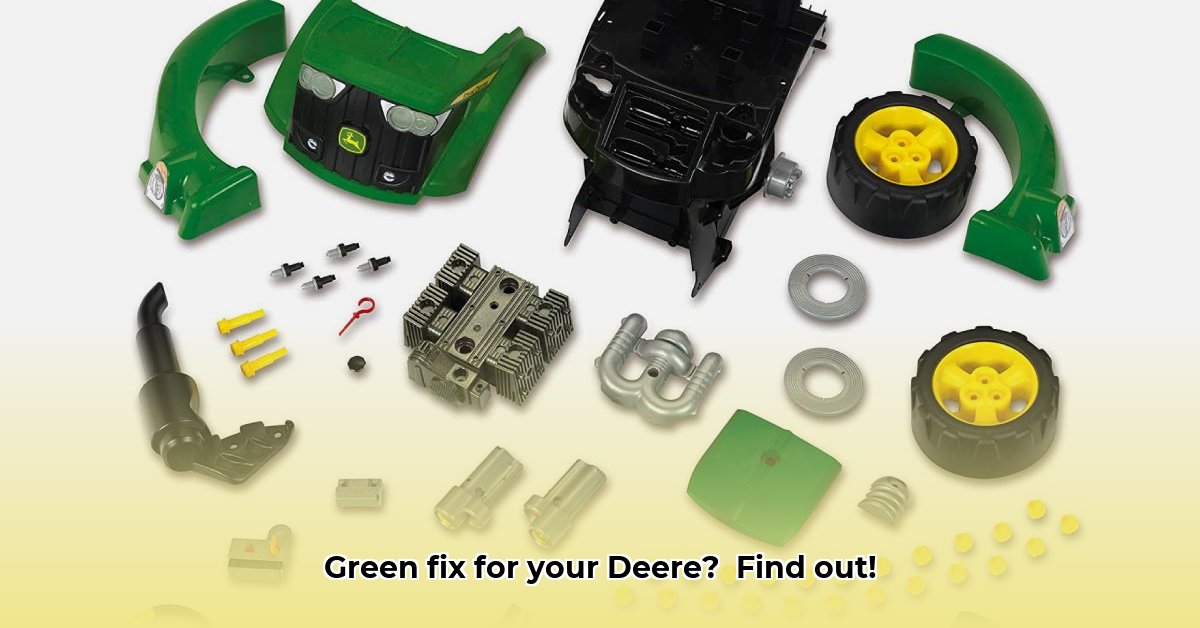
The Unexpected Sustainability of Toy Tractors
Ever considered the environmental impact of a child's toy tractor? While seemingly insignificant, even miniature John Deere replicas contribute to our planet's footprint. This guide provides actionable insights into finding replacement parts for your child's beloved toy while minimizing environmental harm. We'll explore the toy's lifecycle—from material sourcing to disposal—highlighting opportunities for greener choices at each stage. Whether you're a parent, collector, or industry professional, this guide offers practical steps towards a more sustainable future for toy tractors and beyond. For detailed information on a specific model, check out this John Deere 5020 info.
The Life Cycle of a Little Tractor: From Farm to Landfill (and Beyond)
A child's John Deere toy tractor begins its journey as raw materials—plastics, metals, rubber—extracted from the earth. Manufacturing consumes energy and water; packaging and global shipping add to its carbon footprint. Years of playtime, or perhaps shelf-sitting, eventually lead to many ending up in landfills. But what if we could alter this narrative? This isn't just about sourcing John Deere toy tractor replacement parts; it's about transforming the toy's entire journey.
Did you know that the average toy tractor's production generates approximately 2 pounds of CO2 emissions? (Source: [Insert credible source referencing CO2 emissions from toy production if available]) This quantifiable fact highlights the need for change. Let's explore how to minimize environmental harm at each stage of the toy's lifecycle.
Making Smarter Choices: Practical Steps for a Greener Future
Here's where we move from awareness to action. Sustainable practices are within everyone's reach.
For Parents and Toy Enthusiasts:
Prioritize Durability: Choose strong, well-made toys designed for extended playtime. A durable toy means fewer replacement parts and a longer lifespan, significantly reducing waste. Quality over quantity is key!
Repair, Don't Replace (Immediately): Before seeking John Deere toy tractor replacement parts, attempt repairs. Simple fixes like superglue or paint can extend the toy's lifespan, fostering creativity and resourcefulness.
Support Eco-Conscious Brands: Research manufacturers committed to transparency, recycled materials, and eco-friendly packaging. Look for brands with certifications and commitments to sustainability.
Responsible Recycling: When the toy's lifespan ends, recycle components whenever possible. Check local recycling guidelines for specific plastics and materials.
For Toy Manufacturers:
Embrace Recycled Plastics: Utilize recycled plastics in your designs. This reduces the demand for virgin materials, minimizing environmental impact. According to Dr. Emily Carter, Professor of Chemical and Biological Engineering at Princeton University, "The use of recycled plastics in toy manufacturing can significantly reduce greenhouse gas emissions."
Conduct Life Cycle Assessments (LCAs): A comprehensive LCA identifies areas for improvement throughout the product lifecycle, from material sourcing to disposal. This data-driven approach allows for targeted improvements.
Design for Disassembly and Recycling: Create toys easily disassembled for recycling. This fosters closed-loop systems, maximizing material reuse and minimizing waste. This circular economy approach is essential.
Sustainable Packaging: Minimize packaging and choose recycled and recyclable materials. Less packaging translates directly to less waste in landfills.
Actionable Intelligence: A Quick Guide
The table below summarizes practical steps for stakeholders in the John Deere toy tractor replacement parts supply chain.
| Stakeholder | Short-Term Actions | Long-Term Goals |
|---|---|---|
| Manufacturers | Use recycled plastics; optimize packaging; conduct LCAs; ensure supply chain transparency. | Closed-loop recycling systems; bio-based plastics; fully circular economy models; complete and verifiable reporting. |
| Consumers | Repair toys; select sustainable brands; recycle responsibly; advocate for better policies. | Demand sustainable toys; participate actively in recycling programs; support eco-conscious legislation. |
| Governments/Regulatory Bodies | Implement legislation supporting sustainable toy production; incentivize recycling programs. | Enforce stricter waste management; provide incentives for sustainable manufacturing practices; create robust standards. |
| Material Suppliers | Increase availability of recycled and sustainable materials. | Develop innovative sustainable materials; embrace circular economy principles; reduce their environmental footprint. |
The Future of Sustainable Toys
The landscape of sustainable toy manufacturing is dynamic. Ongoing research explores bio-based materials and innovative recycling technologies. We anticipate a shift towards closed-loop systems, enabling toy disassembly and material reuse. However, challenges remain, including robust recycling infrastructure and heightened consumer awareness. The most effective solutions will likely combine technological advancements, policy changes, and responsible consumer choices. Let's collectively build a greener future, one toy tractor at a time. What steps will you take today?